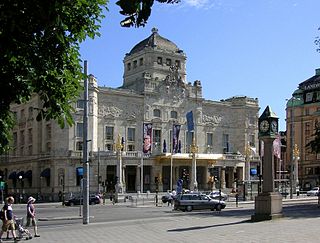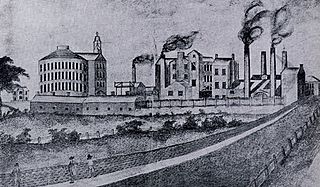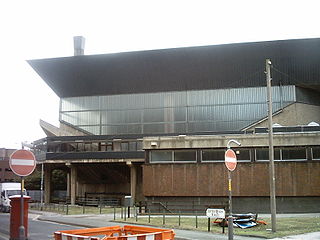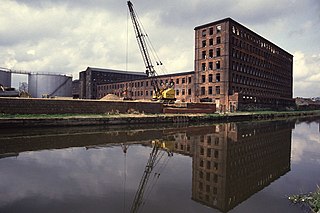
Limelight is a type of stage lighting once used in theatres and music halls. An intense illumination is created when an oxyhydrogen flame is directed at a cylinder of quicklime, which can be heated to 2,572 °C (4,662 °F) before melting. The light is produced by a combination of incandescence and candoluminescence. Although it has long since been replaced by electric lighting, the term has nonetheless survived, as someone in the public eye is still said to be "in the limelight". The actual lights are called "limes", a term which has been transferred to electrical equivalents.

Hunslet is an inner-city area in south Leeds, West Yorkshire, England. It is 1 mile (1.6 km) southeast of the city centre and has an industrial past.

The Theatre Royal, Drury Lane, commonly known as Drury Lane, is a West End theatre and Grade I listed building in Covent Garden, London, England. The building faces Catherine Street and backs onto Drury Lane. The building is the most recent in a line of four theatres which were built at the same location, the earliest of which dated back to 1663, making it the oldest theatre site in London still in use. According to the author Peter Thomson, for its first two centuries, Drury Lane could "reasonably have claimed to be London's leading theatre". For most of that time, it was one of a handful of patent theatres, granted monopoly rights to the production of "legitimate" drama in London.

Tate Wilkinson, English actor and manager.

Cuthbert Brodrick FRIBA was a British architect, whose most famous building is Leeds Town Hall.

The Grand Theatre, also known as Leeds Grand Theatre and Leeds Grand Theatre and Opera House, is a theatre and opera house in Briggate, Leeds, West Yorkshire, England. It seats approximately 1,500 people.

The Royal Dramatic Theatre is Sweden's national stage for "spoken drama", founded in 1788. Around one thousand shows are put on annually on the theatre's eight running stages.

Briggate is a pedestrianised principal shopping street in Leeds city centre, England. Historically it was the main street, leading north from Leeds Bridge, and housed markets, merchant's houses and other business premises. It contains many historic buildings, including the oldest in the city, and others from the 19th and early-20th century, including two theatres. It is noted for the yards between some older buildings with alleyways giving access and Victorian shopping arcades, which were restored in late 20th century. The street was pedestrianised in the early-21st century.

The Round Foundry is a former engineering works off Water Lane in Holbeck, Leeds, West Yorkshire, England. Founded in the late 18th century, the building was developed into the Round Foundry Media Centre in 2005.

Potternewton is a suburb and parish between Chapeltown and Chapel Allerton in north-east Leeds, West Yorkshire, England. It is in the Chapel Allerton ward of Leeds City Council.

The Theatre Royal is an art-deco theatre in Norwich, Norfolk, England. It celebrated its 250th anniversary on the 31st of January 2008 and is one of the country's oldest established theatres. Many well known acts have played here over the years, including Ching Lau Lauro, William Charles Macready, Charles Kean, Tom Thumb and his spouse, Paganini, Donald Sinden, Bernard Cribbins and The Bolshoi Ballet.

Cross Green is a mainly industrial area of Leeds, West Yorkshire, England. It is around 1 mile (1.6 km) on a hill to the south east of Leeds city centre, with the A63 road running through the middle and dividing it into a residential estate with playing fields and housing to the north, and a large industrial estate to the south. The area lies in the LS9 Leeds postcode area between Osmondthorpe, Richmond Hill and Hunslet.

The Leeds International Pool often referred to as the Leeds International Baths, was a swimming facility in Leeds city centre, West Yorkshire, England. The pool was situated at the lower end of Westgate and was notable for its brutalist architecture. The pool was constructed in the 1960s and designed by architect John Poulson.

The architecture of Leeds, a city and metropolitan borough in West Yorkshire, England, encompasses a wide range of architectural styles and notable buildings. As with most northern industrial centres, much of Leeds' prominent architecture is of the Victorian era. However, the City of Leeds also contains buildings from as early as the Middle Ages such as Kirkstall Abbey, one of Britain's best preserved ruined Cistercian monasteries, as well as examples of 20th century industrial architecture, particularly in the districts of Hunslet and Holbeck.

Chapel Allerton is an inner suburb of north-east Leeds, West Yorkshire, England, 2 miles (3.2 km) from the city centre.

The Hunslet Mill and Victoria Works Complex is a series of very large disused mill buildings in Goodman Street in Leeds.
Ching Lau Lauro and Professor Ching were the stage names of a juggler and magician who performed outdoors and in theatres in London and the provinces. His real name is unknown; he was possibly Cornish and he was popularly known as Ching. He was the first magician in Europe to perform the aerial suspension illusion, and possibly the first to use limelight, and one of the earliest Western magicians to perform in Chinese costume. In 1834 he played at The Theatre, Leeds.

The Pavilion Theatre at 191–193 Whitechapel Road, London, was the first major theatre to open in London's East End. It was destroyed by fire in 1856 and rebuilt as the New Royal Pavilion Theatre, which operated until 1935.
Benjamin Burstall was a sculptor, architectural sculptor and stone carver, based in Leeds, West Riding of Yorkshire, England.





















